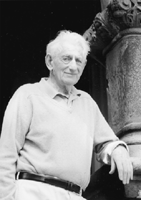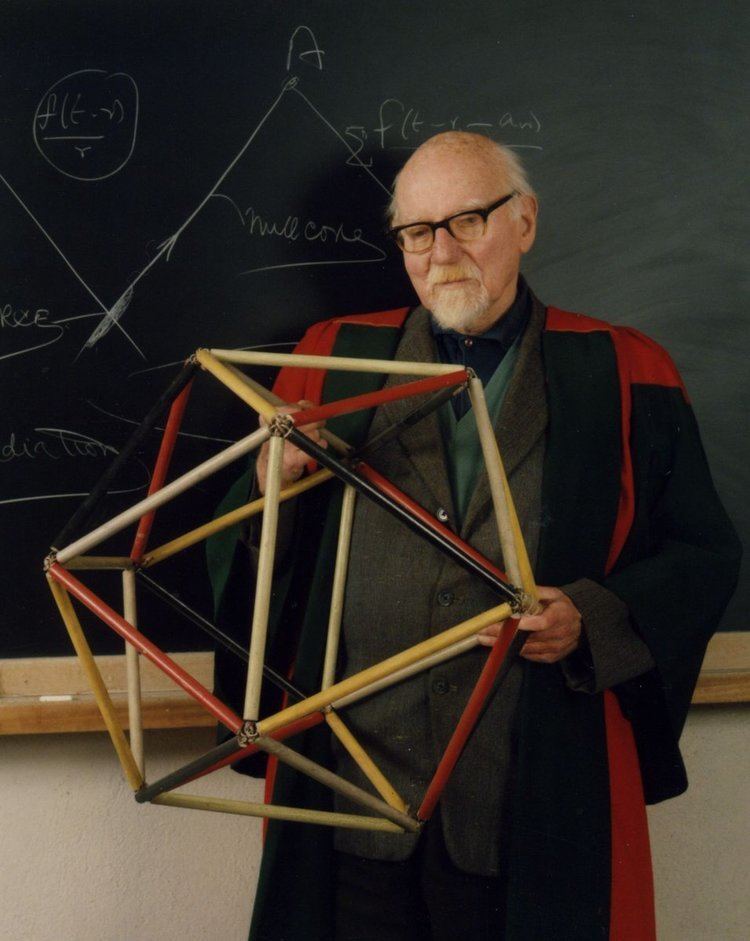Name John Synge Role Mathematician | Children Cathleen Synge Morawetz | |
 | ||
Books Principles of Mechanics, The hypercircle in mathe, Tensor calculus, Geometrical mechanics and de Br, Geometrical Optics: An Introducti | ||
Education Trinity College, Dublin | ||
John Lighton Synge (; 23 March 1897 – 30 March 1995) was an Irish mathematician and physicist, whose seven decade career included significant periods in Ireland, Canada, and the USA. He was a prolific author and influential mentor, and is credited with the introduction of a new geometrical approach to the theory of relativity.
Contents

Background
Synge was born 1897 in Dublin, Ireland, into a prominent Church of Ireland family. He attended St. Andrew's College, Dublin and in 1915 entered Trinity College Dublin. He won a Foundation Scholarship in his first year, which was unusual as it was normally won by more advanced students. While an undergraduate at TCD, he spotted a non-trivial error in Analytical Dynamics, a textbook by E. T. Whittaker, who had recently taught there, and notified Whittaker of the error. In 1919 he was awarded a B.A. in Mathematics and Experimental Physics, and also a gold medal for outstanding merit. In 1922 he was awarded an M.A., and in 1926 a Sc.D., the latter upon submission of his published papers up to then.
In 1918, Synge had married Elizabeth Eleanor Mabel Allen (1896–1985). She was another student at TCD, first of mathematics, then of history, but family finances forced her to leave without graduating. Their daughters Margaret (Pegeen), Cathleen and Isabel were born in 1921, 1923 and 1930 respectively. The middle girl grew up to become the distinguished Canadian mathematician Cathleen Synge Morawetz.
Synge's uncle John Millington Synge was a famous playwright. He is more distantly related to the 1952 Nobel prizewinner in chemistry Richard Laurence Millington Synge. He was a great-great-great-grandson of the mathematician and bishop Hugh Hamilton.
His older brother, Edward Hutchinson Synge (1890-1957), who was known as Hutchie, also won a Foundation Scholarship in Trinity for Mathematics, though he never graduated. While Hutchie's later independent research was long overlooked, he is now recognised for his pioneering work in optics, particularly in near field optical imaging.
He died on 30 March 1995 in Dublin.
Career in mathematics and physics
Synge was appointed to the position of lecturer at Trinity College, and then accepted a position at the University of Toronto in 1920. From 1920 until 1925, Synge was an assistant professor of mathematics at the University of Toronto. There he attended lectures by Ludwik Silberstein on the theory of relativity, stimulating him to contribute "A system of space-time co-ordinates", a letter in Nature in 1921.
Synge returned to Trinity College Dublin, in 1925, where he was elected to a fellowship and was appointed the University Professor of Natural Philosophy (the old name for physics). He was a member of the American Mathematical Society and the London Mathematical Society. He was treasurer of the Royal Irish Academy in 1929. He went back to Toronto in 1930, where he was appointed Professor of Applied Mathematics and became Head of the Department of Applied Mathematics. In 1940, he supervised three Chinese students, Guo Yonghuai, Chien Wei-zang and Chia-Chiao Lin, who later became leading applied mathematicians in China and the United States.
He spent some of 1939 at Princeton University, and in 1941, he was a visiting professor at Brown University. In 1943 he was appointed as Chairman of the Mathematics Department of Ohio State University. Three years later he became Head of the Mathematics Department of the Carnegie Institute of Technology in Pittsburgh, where John Nash was one of his students. He spent a short time as a ballistic mathematician in the US Air Force between 1944 and 1945.
He returned to Ireland in 1948, accepting the position of Senior Professor in the School of Theoretical Physics at the Dublin Institute for Advanced Studies. This school had been set up in 1940, and had several outstanding members, including Erwin Schrödinger (who contributed to quantum mechanics), who was also a Senior Professor.
His contributions
Synge made outstanding contributions to different fields of work including classical mechanics, general mechanics and geometrical optics, gas dynamics, hydrodynamics, elasticity, electrical networks, mathematical methods, differential geometry, and Einstein's theory of relativity. He studied an extensive range of mathematical physics problems, but his best known work revolved around using geometrical methods in general relativity.
He was one of the first physicists to seriously study the interior of a black hole, and is sometimes credited with anticipating the discovery of the structure of the Schwarzschild vacuum (a black hole).
He also created the game of Vish in which players compete to find circularity (vicious circles) in dictionary definitions.
Honours
Synge received many honours for his works. He was elected as a fellow of the Royal Society of London in 1943. He was elected as a fellow of the Royal Society of Canada, and in 1943 was the first recipient of the society's Henry Marshall Tory Medal, as one of the first mathematicians working in Canada to be internationally recognised for his research in mathematics. He was president of the Royal Irish Academy from 1961 until 1964. The Royal Society of Canada established the John L. Synge Award in his honour in 1986.
John Lighton Synge retired in 1972. During his time at the Dublin Institute for Advanced Studies, about 12% of all workers in the relativity theory studied there. Professor Hermann Bondi, who gave the first J. L. Synge Public Lecture in 1992, had this to say: "Every one of the other 88% has been deeply influenced by his geometric vision and the clarity of his expression". He was awarded the Boyle Medal by the Royal Dublin Society in 1972.
During his long scientific career, Synge published over 200 papers and 11 books. He proved the result now known as Synge's theorem.
